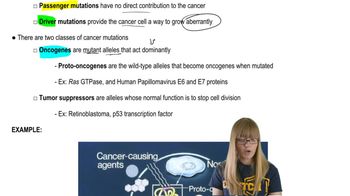Table of contents
- 1. Introduction to Genetics51m
- 2. Mendel's Laws of Inheritance3h 37m
- 3. Extensions to Mendelian Inheritance2h 41m
- 4. Genetic Mapping and Linkage2h 28m
- 5. Genetics of Bacteria and Viruses1h 21m
- 6. Chromosomal Variation1h 48m
- 7. DNA and Chromosome Structure56m
- 8. DNA Replication1h 10m
- 9. Mitosis and Meiosis1h 34m
- 10. Transcription1h 0m
- 11. Translation58m
- 12. Gene Regulation in Prokaryotes1h 19m
- 13. Gene Regulation in Eukaryotes44m
- 14. Genetic Control of Development44m
- 15. Genomes and Genomics1h 50m
- 16. Transposable Elements47m
- 17. Mutation, Repair, and Recombination1h 6m
- 18. Molecular Genetic Tools19m
- 19. Cancer Genetics29m
- 20. Quantitative Genetics1h 26m
- 21. Population Genetics50m
- 22. Evolutionary Genetics29m
17. Mutation, Repair, and Recombination
Types of Mutations
Problem 1f
Textbook Question
In this chapter, we focused on how gene mutations arise and how cells repair DNA damage. At the same time, we found opportunities to consider the methods and reasoning by which much of this information was acquired. From the explanations given in the chapter,
How do we know that mutations occur randomly?
 Verified step by step guidance
Verified step by step guidance1
Understand the concept of random mutations: Mutations are changes in the DNA sequence that occur without a specific direction or purpose. They can happen at any location in the genome and are not influenced by the needs of the organism.
Review historical experiments: One of the key experiments demonstrating the randomness of mutations was the Luria-Delbrück experiment, also known as the fluctuation test. This experiment showed that mutations in bacteria occurred randomly and not as a response to environmental pressures.
Consider the role of DNA replication errors: During DNA replication, errors can occur randomly, leading to mutations. These errors are not directed or influenced by external factors, supporting the idea of randomness.
Examine the impact of mutagens: While certain chemicals or radiation can increase the mutation rate, the specific mutations that occur are still random. Mutagens do not direct mutations to specific genes or locations.
Explore statistical analysis of mutation patterns: By analyzing the distribution and frequency of mutations across populations, scientists can determine that mutations occur randomly rather than in a predictable pattern.
 Verified video answer for a similar problem:
Verified video answer for a similar problem:This video solution was recommended by our tutors as helpful for the problem above
Video duration:
29sPlay a video:
Was this helpful?
Key Concepts
Here are the essential concepts you must grasp in order to answer the question correctly.
Gene Mutations
Gene mutations are changes in the nucleotide sequence of DNA that can occur due to various factors, including errors during DNA replication, environmental influences, or spontaneous chemical changes. These mutations can be classified as point mutations, insertions, deletions, or larger chromosomal alterations, and they can affect gene function, leading to phenotypic changes.
Recommended video:
Guided course

Cancer Mutations
Randomness of Mutations
The randomness of mutations refers to the idea that mutations occur without any specific direction or purpose, often influenced by chance events during DNA replication or external factors. This concept is supported by statistical analyses showing that mutations arise independently of the organism's needs, leading to a diverse range of genetic variations.
Recommended video:
Guided course

Point Mutations
DNA Repair Mechanisms
DNA repair mechanisms are cellular processes that correct damage to the DNA molecule, ensuring genomic stability. These mechanisms, such as nucleotide excision repair and mismatch repair, help to fix mutations that occur, but they also highlight the occurrence of mutations as a natural part of cellular processes, reinforcing the idea that mutations can arise randomly.
Recommended video:
Guided course

Repair Pathways





